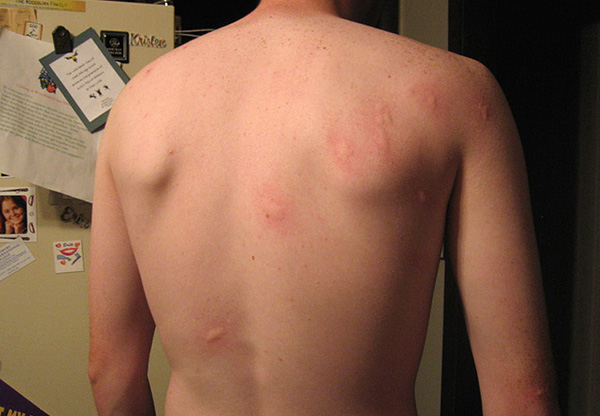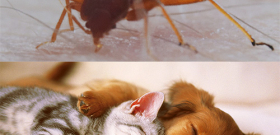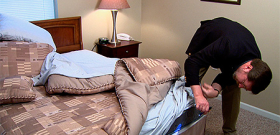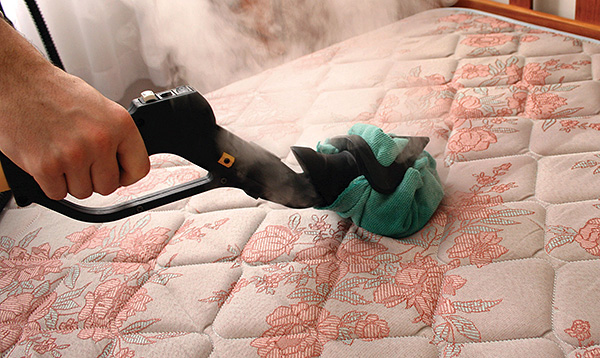
Practice shows that people usually call "bed mites" either bed bugs or dust mites, which also often inhabit mattresses and pillows (especially down pillows). In the following, we will consider both variants of the problem in detail.
Bed bugs are typical parasites that feed on human blood. Their bites lead to the formation of itchy redness on the body and even blisters that do not go away for a long time (in people prone to insect allergies). With a strong infestation of the premises with bedbugs, it will not be such an easy task for an unprepared person to remove these parasites.
The photographs below show bed bugs and the characteristic appearance of their bites:
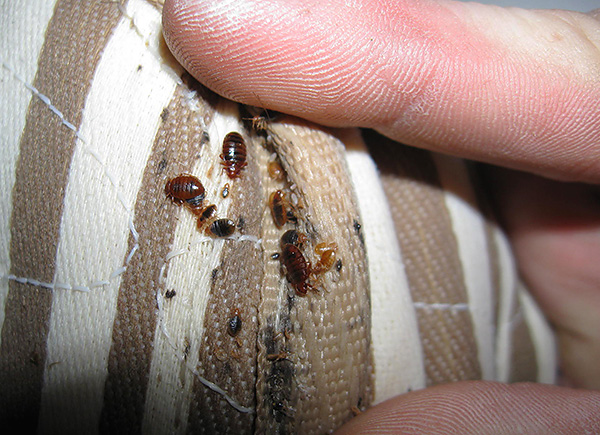
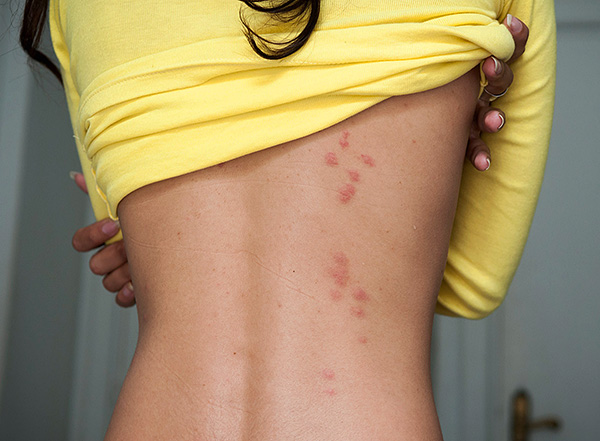
But dust mites are not parasites - they do not bite humans and domestic animals, do not spoil household items and food, and could be considered quite cute creatures, if not for one small, but very unpleasant detail. The fact is that the excrement of dust mites are very powerful allergens and can cause the so-called tick-borne sensitization, which is not far from excruciating asthma and debilitating chronic rhinitis.
In the photo - a dust mite in a pillow (at high magnification):
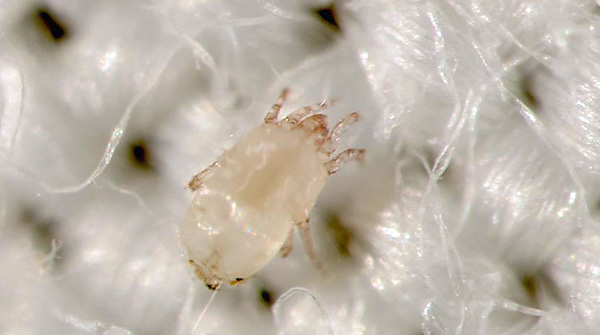
Next, we will take a closer look at how to correctly recognize who exactly settled in bed and, most importantly, how to effectively get rid of uninvited guests, regardless of whether they are bed bugs or house mites ...
What are bed mites and where to look for them
Bed mites are the common name for dust mites that belong to the family of pyroglyphs and have little in common with those forest parasites that attack humans or dogs when going out into the countryside. They specialize in feeding on particles of exfoliating human skin and therefore live where there is a lot of this food - in places of accumulation of house dust, as well as in sleeping places. Moreover, the less often cleaning is carried out in the room, the less often the bed is changed and mattresses and carpets are shaken out, the more ticks there are.
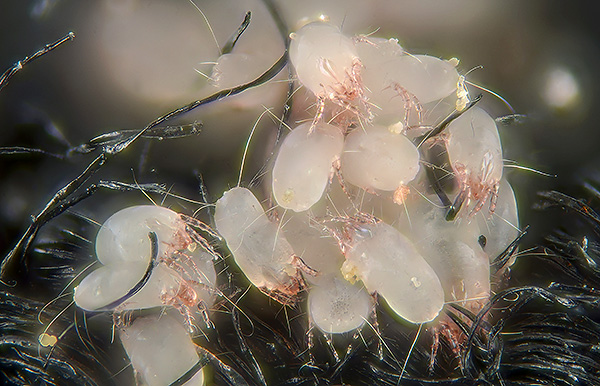
Human dwellings are inhabited by several types of dust mites. The most common are the American dust mite Dermatophagoides farinae and the European dust mite Dermatophagoides pteronyssinus, as well as the Mainey mite Euroglyphus maynei. Representatives of these species are difficult to distinguish from each other even under a microscope.
On a note
The word Dermatophagoides means that the mite is a dermatophagus, that is, it feeds on the skin (from the Greek derma - skin, phagos - to devour).
Dust mites are relatively small, making them difficult to detect. The length of an adult is about 0.3 mm, and due to the light translucent body, it is rather problematic to see a separate individual with the naked eye on bedding. Without a microscope, they can be more or less clearly seen only in large accumulations in the dust, where they look like peculiar whitish dots.
The photo below shows an adult Dermatophagoides pteronyssinus:
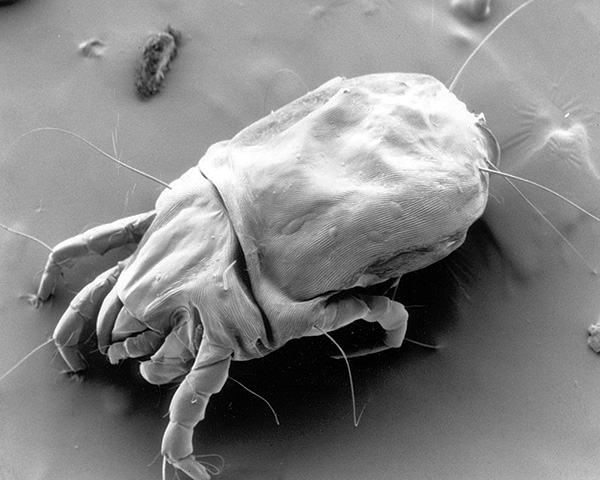
The following photograph, also taken under a microscope, shows a cluster of dermatophagous mites in a carpet:

Dust mites feed on the dry, crumbling skin of humans and pets. It is known that each adult loses on average about 0.5-1.5 g of skin daily with dandruff and normally exfoliating epidermis. This amount is quite enough to feed many thousands of dust mites within one apartment.
It is interesting
According to studies, these arthropods also eat molds, which, however, cannot be the basis of their diet. In other words, in an apartment with people, but without mold, ticks will live quite normally, but in a room with moldy walls, but without people, they will not be able to live for a long time. That is, mold for them is just a kind of supplement that cannot replace the main diet.
Being unable to move long distances due to their slowness and small size (and not needing such movements due to the absence of dangers), dust mites settle and accumulate in rooms where a person spends most of the time and where the greatest amount of lost energy accumulates. them skin. In particular, such places are sofas and beds, pillows, mattresses, armchairs, and the owners of the apartment call the dermatophagous mites found here with a light hand, bed, sofa, mattress, bed, feather bed, etc. It is important to understand that in all these cases it is is about the same dust mites.
The danger of dust mites to humans
House dust mites could be completely harmless human skin utilizers if they did not cause allergic reactions and respiratory diseases in humans.
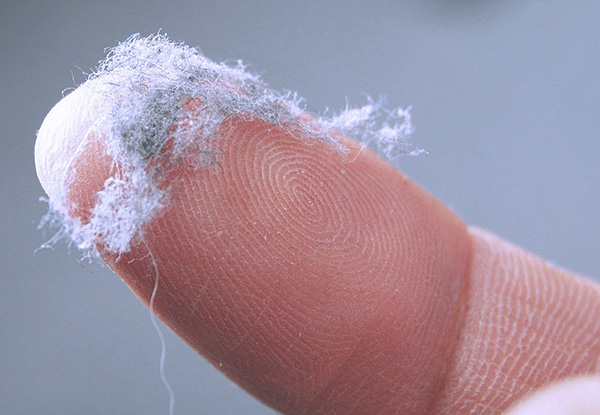
The digestive tract of dermatophagous mites contains special enzymes with high biological activity. Some of these enzymes are released along with excrement, which are very small (hundredths of a millimeter) and easily get into the air - along with house dust. Over time, the excrement particles dry out and break up into even smaller fragments, which can rise into the air with dust even faster and easier.
Due to their high biological activity, the digestive enzymes of bed mites are strong allergens and cause allergies in many people. They can irritate the surfaces of the mucous membranes of the respiratory tract, acting destructively on epithelial cells (just as they act on skin particles consumed by mites). Both allergies and irritations lead to swelling and inflammation of the mucous membrane of the entire respiratory tract, which can be manifested by the following symptoms and end pathologies:
- Itching in the nose, rhinorrhea;
- "Dry" nasal congestion without runny nose;
- allergic rhinitis;
- Allergic conjunctivitis or rhinoconjunctivitis;
- Chronic rhinitis.
Over time, in many patients, against the background of tick-borne sensitization, allergic rhinitis turns into asthma. It is believed that more than half of the cases of asthma in the world develop precisely because of allergies or irritation in response to the inhalation of dust with mite antigens. And for many people who do not understand why they have a stuffy nose at night and, it would seem, for no reason, the problems are often associated with the same inconspicuous bedmates.

On a note
Cases of the development of anaphylactic shock in allergy sufferers after eating foods that have clusters of dust mites are described.Also, from the contact of dust containing mite antigens with the skin, especially sensitive people may develop a characteristic allergic rash with the formation of small pimples.
At the same time, it should be noted that if someone bites you regularly in bed, and in the morning there are traces of night bites on your body that itch and itch, these are definitely not ticks. Dust mites do not bite and leave no bite marks.
Bed bugs and their bites
Bed bugs got their name for the reason that, being synanthropic parasites, they are most often found in a person’s bed (and they arrange their “nests” most often here, or in the immediate vicinity of people’s places of rest - next to beds, sofas, armchairs) .

It is interesting
Initially, bed bugs were known only as permanent inhabitants of human housing. Later studies showed that these insects are also found in caves, where they parasitize bats. Perhaps it was in the caves that the bugs first "met" with primitive people and forever became their neighbors, first roaming in their belongings, and then firmly settling in housing. However, such wild populations of bed bugs are relatively small compared to populations living in human homes.
With dust mites (as well as with other types of mites), bed bugs have nothing in common. To begin with, all ticks are representatives of the arachnid class (they have 4 pairs of legs), and bedbugs are insects (they have 3 pairs of legs). At the same time, outwardly, these creatures differ significantly - even the smallest bug larva (more correctly, a nymph) is clearly visible to the naked eye, while even an adult dust mite is microscopically small.
This is what a bed bug nymph looks like:
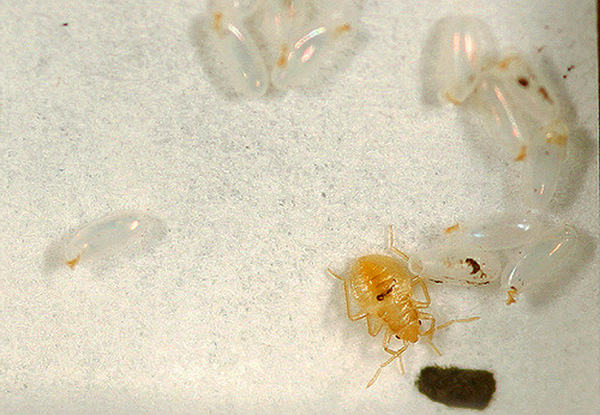
Adult bed bugs have a wide, rounded body, flattened at the top when hungry, and reach a length of 1 cm or more. When saturated, they strongly swell and lengthen the abdomen. Then, as the food is digested and stooled, they again become like a button or a small coin.
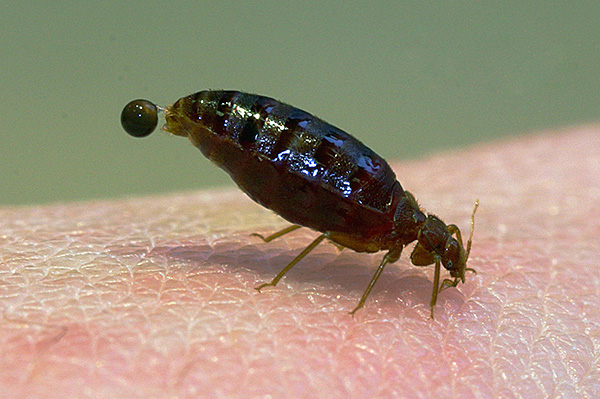
Small larvae (nymphs) of bed bugs have a translucent body and look like light little bugs. Most of the bedbugs living indoors are nymphs of different ages and, accordingly, of different sizes (from 1 mm or more in length).
Bed bugs feed only on human blood (in rare cases they also bite domestic animals) - they pierce the skin and blood vessel with their proboscis, and then suck up the blood. After saturation, each insect hides in a secluded shelter near the site of the attack and stays there for several days until the next outing (larvae feed more often than adults). So it is imperative to get rid of bedbugs as soon as possible - otherwise the bites will not stop by themselves, since bloodsucking is vital for these parasites.
Interestingly, for many centuries of living next to a person, bed bugs have adapted well to his rhythm of life. They attack almost exclusively at night, when people are close to the shelters of parasites, while they sleep and do not pose a great danger to insects. In the daytime, bedbugs attack much less frequently, mainly after a long hunger.
It is bites that are the main danger of bed bugs.Most people are quite sensitive to them, itchy blisters often appear at the site of the bites, which the victims often comb, increasing itching, sometimes provoking infection and the appearance of pustules. In children, with a large number of bedbug bites, the temperature may rise, and the affected areas swell greatly.
On a note
The situation is aggravated by the fact that each bug usually bites several times during feeding (with the exception of only the smallest nymphs). At the site of each bite, a blister remains, and after the bites of many bedbugs, the whole body is covered with itchy bumps.
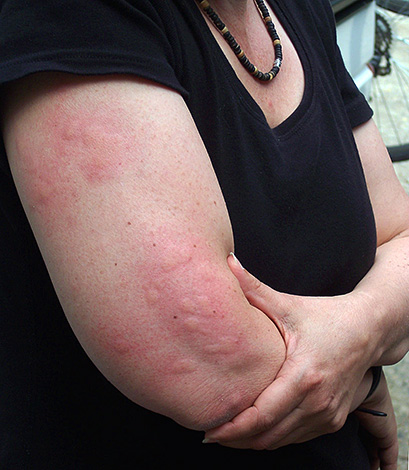
Often, the victim develops an allergy to bedbug bites. Cases of life-threatening reactions have not been described, but severe conditions may well be observed, especially in children.
For the treatment of the bites themselves, ointments with painkillers and anti-inflammatory components are used. If the allergy is extensive and manifests itself with signs of urticaria, it should be treated under the guidance of a doctor using, among other things, effective antihistamines.
Similarly to the situation with dust mites, an allergy can also develop on the waste products of bedbugs - the remains of chitinous covers remaining after molting, excrement, egg shells. Moreover, all these allergens are located near the place where a person sleeps and can easily be inhaled with air. They can also cause atopic chronic rhinitis and asthma.
On a note
It is noteworthy that, in fact, bed bugs do not infect people with infections. They can be carriers of dangerous viruses (after bloodsucking on infected people), but there have been no cases of transmission of infection from one person to another.In this way, bedbugs differ from other synanthropic blood-sucking parasites - linen and head lice, fleas, which may well infect a person with a dangerous disease (typhoid, plague, etc.)
How, at home, to clearly understand which parasites or pests have settled in bed? It's pretty easy to do this...
We identify the parasite
The most effective thing you can do to identify an intruder in bed is to try to find him and examine him. To do this, it is useful to carefully consider the mattress, pillow, bedding, the bed itself (sofa). Already at this stage, fleas, lice and sometimes bedbugs can be accurately identified.
Fleas look like small (2-3 mm in length) dark brown or black shiny dots, which, when you try to take them with your fingers, seem to disappear from the place where they were - they jump 20-30 cm. Simply put, if the parasite deftly and jumps far - it's a flea. When viewed under a magnifying glass, its body is clearly flattened from the sides and characteristically elongated hind legs, with which it repels for a jump (see the photo below):

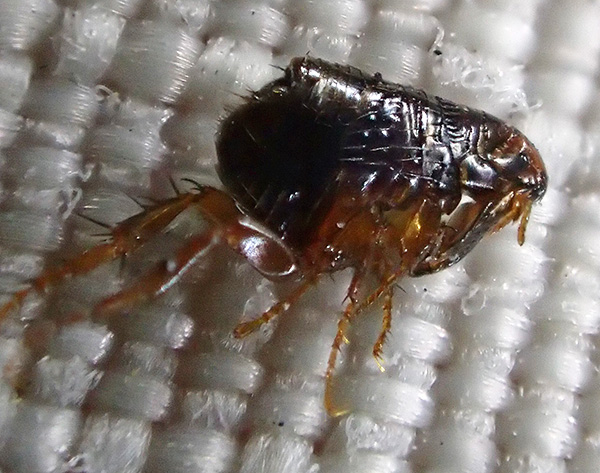
If the insect does not jump, but simply crawls along the bed, it can be either a louse or a bug. Moreover, small larvae of bedbugs can be quite confused with lice - they have similar sizes.
Here is a photo of a head louse (the linen louse looks the same):
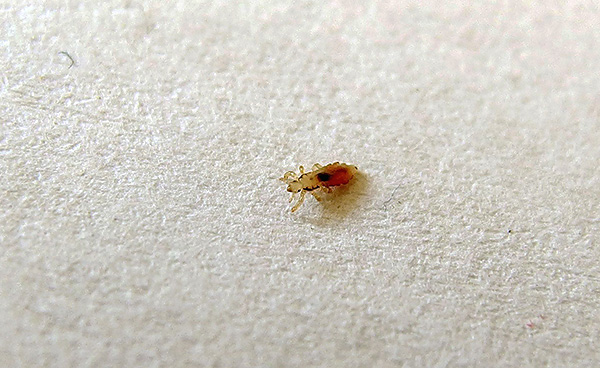
Pubic lice:
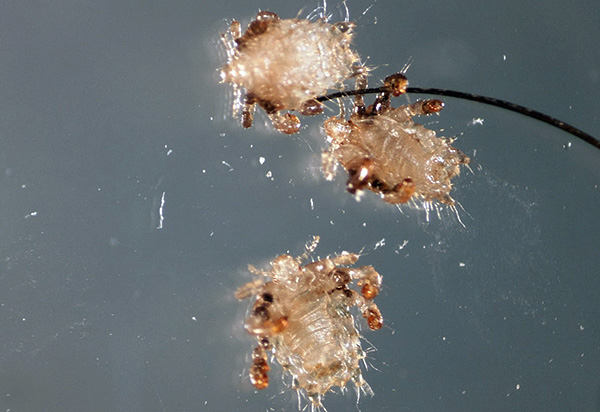
All these types of lice are rather slow (which cannot be said about bedbugs). It is important to understand here that a louse that fell from the head, body or underwear could only be taken from the body of the person who is sleeping here. This person needs to be looked at.
And this is what bed bugs look like:

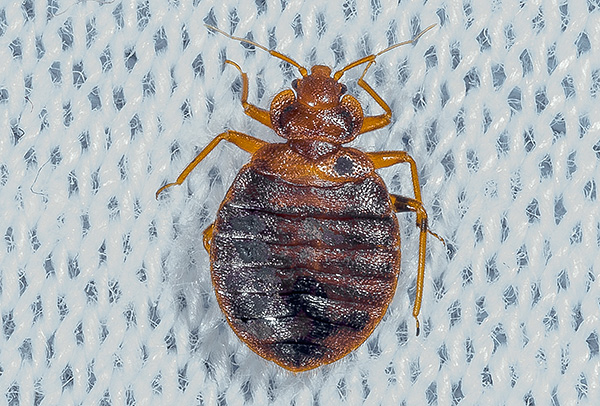
If a bug is found, then with a high probability somewhere nearby - maybe in a bed or near it - there is a whole nest of these parasites, since they do not settle in the apartment one by one, and spend most of their time in shelters.
Also a characteristic sign of the presence of bedbugs in the house are such spots of blood on bedding:
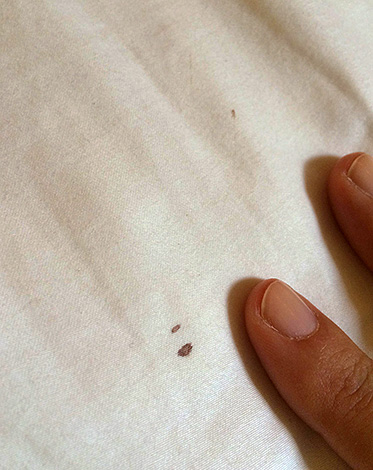
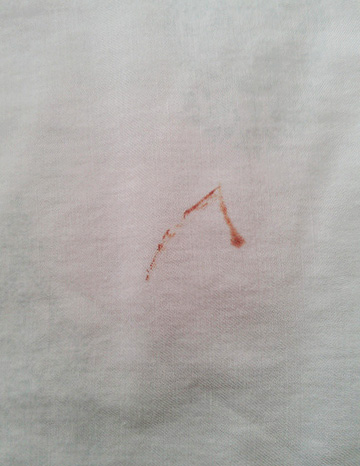
These blood marks are formed when a sleeping person in a dream lightly presses a satiated bug.
Additionally, the identification result can be confirmed by the bite sites. If they concentrate on the head or in the groin, that is, on the parts of the body covered with hair, then most likely they are left by lice - they live in the hair and attach their eggs (nits) here. Bedbugs, on the contrary, avoid hairy areas of the body and bite mainly on the stomach, sides, neck, arms and legs.
On a note
Another characteristic difference between bedbug bites is that they are located in small paths - 2-4 bites each. As noted above, adult bugs bite several times during one feeding, while each new puncture is made by the parasite a few centimeters from the previous one. Accordingly, 3-4 bites of each bloodsucker will be lined up in a kind of path along which the parasite moved. If such paths were found on the body, then almost certainly bedbugs live in the house.
The photo below shows what the bite marks of bed bugs look like on the body of the victim:
Dust mites differ from the above parasites in that they are usually impossible to find in bed during a simple examination. They are too small for this, and even looking at point-blank range, they can be overlooked, especially on a light bed.More or less distinguishable can be clusters of mites that look like white grains (such clusters are usually located inside pillows and mattresses).
What to do if there is a suspicion of the presence of dust mites in the bed?
Special test systems will help here: analyzers, in which it is enough to add dust from the bed, from the floor near the bed, from any other place in the apartment, pour water and lower a chemically sensitive piece of paper. In this case, the paper takes on a certain color, which must be compared with the color on a special scale of the analyzer. So, by color, you can understand how many dust mite antigens are in the dust sample. In fact, this shows how many mites live near the place where the dust was collected.

If, according to the test results, it turned out that an increased concentration of tick-borne antigens is found in one place or another, this is enough to start the fight against dust mites, even if it was not possible to find, see and examine them, for example, with a magnifying glass or microscope.
On a note
Dust mites are ubiquitous and are found today in the vast majority of apartments and houses. Initially, they appear indoors with dust on shoes, things, bags, various items, and if the conditions in the apartment are suitable, then they actively multiply here. In fact, they constantly penetrate into every apartment, and it depends only on whether the room is kept clean, whether the mites multiply in large numbers, or whether they are massively removed with dust during each cleaning.
Of all the parasites and pests listed above, bed bugs are the most difficult to deal with - we'll talk further about how to get rid of them ...
Destruction of bed bugs in the house
The extermination of bedbugs in the room is a serious task that requires some preparation and careful implementation of all work. An attempt to carry it out half-heartedly usually leads to the fact that it is not possible to completely remove the bugs, over time, the surviving individuals multiply again and the pest control has to be repeated, sometimes many times (some people live with bugs for years, periodically making not very active attempts to get rid of them).
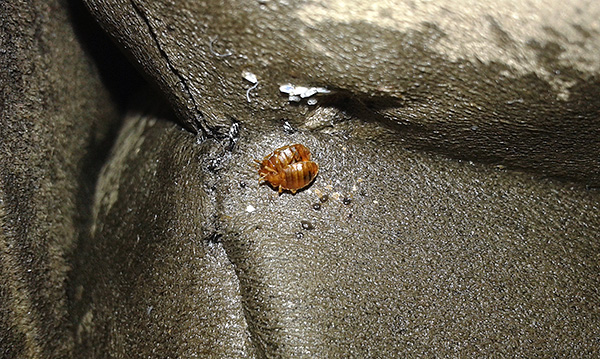
The fight against bedbugs itself should take place in the following sequence:
- All places where bedbug nests are located (the so-called foci of infection) are identified and opened;
- Be sure to find out where the bugs come from in the room. If they live with neighbors, you need to find the passages through which the parasites penetrated from the neighbors into the apartment, and block them;
- Measures are being taken to destroy the parasites present in the room;
- After 10-14 days, even if bedbugs are no longer found in the apartment and no one bites at night anymore, the treatment is repeated (this is how the larvae that hatch from the eggs that survived after the first treatment are destroyed). If, after the first treatment, the number of bedbugs has not decreased, then a second pest control must use a different agent (often in populations of bed bugs resistance to certain types of insecticides is observed).
You can destroy bedbugs by chemical and thermal methods.The former involve the use of powerful insecticides, the latter - freezing the room or treating the places where bugs accumulate with steam from a steam generator (less often, with the help of special heat guns, they heat the entire room to 65 degrees).
Practice shows that the use of insecticides gives a more reliable and faster result. However, as an addition, hot steam treatment of mattresses is also quite appropriate.
Of the chemicals for the destruction of parasites, both aerosols are used, which are already sold in cylinders and are ready for spraying (Combat, Raptor, Raid, Chisty Dom, etc.), and concentrated preparations that must be diluted with water before preparation and sprayed in the form of a spray from hand spray guns (Executioner, Delta Zone, Get, Lambda Zone, Karbofos, Xulat Micro and others).
On a note
Folk remedies - herbs, alcohol, turpentine, vinegar - in practice do not allow to effectively destroy either bed bugs or dust mites. For several days, with the help of such means, it is possible to reduce the activity of arthropods, but it will not work to completely remove them from the apartment.
It is partly because of the complexity of the process that it is not always possible and not for everyone to destroy bed bugs on their own. Even if the purchased product turns out to be quite effective and really destroys insects, some parasites often survive indoors due to the fact that the owners are too lazy to move and disassemble furniture (sometimes bugs hide under the sheathing, and you even need to remove it), look for nests behind baseboards and under wallpaper, in bed frames. As a result, these places are not treated with insecticide, and live bugs remain here.
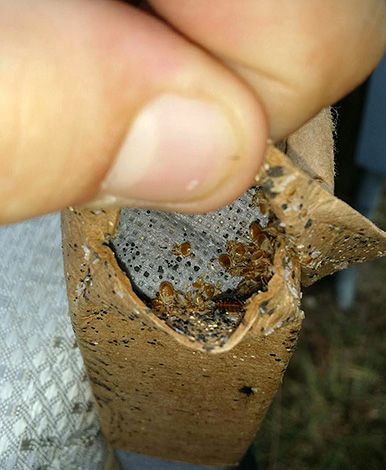
On a note
In some cases, for the effective destruction of bed bugs, it makes sense to completely remove the parquet and change the wallpaper, that is, in fact, to make a major overhaul in the apartment. And judging by the reviews, it can be easier for people to move out of the apartment than to get rid of the parasites (especially if the entire apartment building is infected with them).
More often, failures are due to the fact that before processing, measures are not taken to isolate the apartment from neighboring premises. If the bugs come precisely from the neighbors, then even the complete destruction of the parasites in the apartment will give only a temporary result: in a week or two new bloodsuckers will penetrate here and start biting people again.
If you initially have a feeling that it will be problematic to deal with bedbugs on your own, then it makes sense to call a pest control service. The services of such services, although they cost more than you have to spend on the drug, but provide a high probability of complete elimination of insects.
Tick Control Rules
Dust mites are generally easier to deal with than bed bugs. These creatures are less mobile and more sensitive to the sanitary condition of the premises. In most cases, relatively simple but systematic measures are sufficient to eliminate them.

In particular, it is necessary:
- Carry out a thorough wet cleaning throughout the apartment;
- Change bed linen;
- Dry-clean pillows and blankets and (or) wash them at a temperature of 60-70 ° C for at least 30 minutes (at this temperature, mite eggs die, among others);
- Mattresses "fry" in the sun or treat with hot steam;
- Remove dust from all cracks, from under furniture, carpets and rugs.
There are also special vacuum cleaners for getting rid of dust mites:
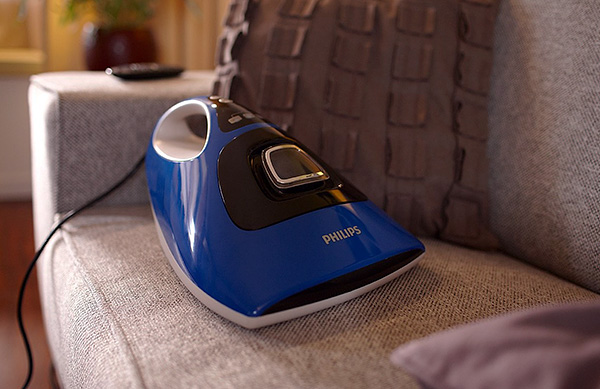
However, it is quite effective to remove dust from those places where ticks have settled, it is possible with an ordinary vacuum cleaner in combination with a damp cloth.
Also, ticks die from the same insecticidal agents that poison bedbugs and cockroaches. The use of such drugs will give a well-defined quick effect, however, with due care and mechanical and thermal methods alone, it may be quite enough.
If, in the future, the premises are maintained in good sanitary condition, “bed” mites will not multiply here, and will no longer pose a danger.
Effective Prevention Measures
Reliable prevention from the appearance and reproduction of dust mites in bed is to maintain cleanliness in the apartment as a whole (first of all, dust control is important).
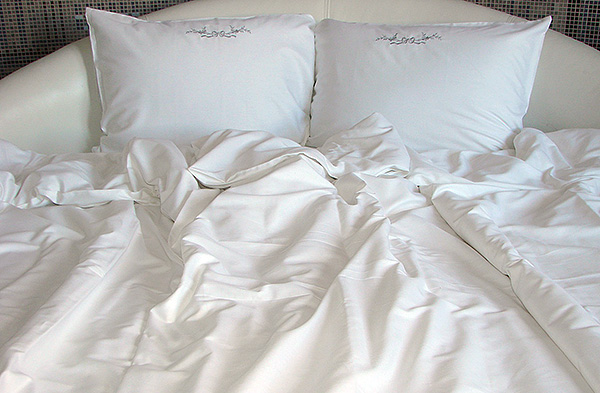
The World Health Organization recommends the following measures to protect the premises from ticks:
- Carry out a thorough wet cleaning at least once a week. As part of the cleaning, dust should be removed, including from under the furniture;
- Change and wash bedding at least once a week;
- Once every 2-3 months, you need to wash those mattresses that are not completely covered with bed linen and on the surface of which dust can get;
- Use bed linen from fabrics with the following characteristics: the size of the pores is not more than 10 microns, the ability to retain allergens is 99%, the ability to pass dust is not more than 4%.
The only reliable prevention against infestation of a room with bed bugs is its high-quality isolation from neighboring apartments and a strict check of all large items brought in here - especially furniture, as well as bags, suitcases and clothes after vacationing at resorts and business trips with hotel accommodation.Various folk remedies like wormwood or tansy do not represent a serious obstacle to the movement of bedbugs. Although insects are afraid of their smell, in case of acute hunger they will bypass them in search of prey.
If you have personal experience dealing with bed bugs or dust mites, be sure to leave a review at the bottom of this page (in the comment box). By what signs did you manage to find the source of the problem, what actions were taken and whether they gave a result - those who are in the same situation will be interested in any details.
An interesting video demonstrating many dust mites in a pillow

